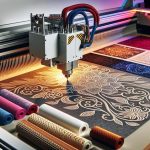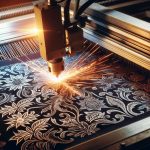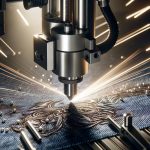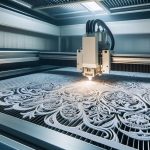Mastering laser engraving on fabrics opens up loads of creative possibilities. You'll find precision designs are easier to achieve thanks to lasers, but you'll need to understand how different fabrics react. Cotton and linen excel with intricate patterns, whereas polyester might need some tweaking. Techniques like raster and vector engraving can shape fine details or bold lines. Think personalized denim, customized handbags, or engraved logos on clothing. While the initial setup can be pricey, the lasting durability and unique results are well worth it. There's more to explore on techniques and overcoming challenges ahead.
Table of Contents
Key Takeaways
- Laser engraving on fabrics requires adjusting settings for different materials to achieve precise and intricate designs.
- Raster and vector engraving techniques offer flexibility in creating both detailed patterns and clean, sharp lines.
- Natural fibers like cotton and linen are ideal for laser engraving, while synthetic fabrics may need specific adjustments.
- Creative applications include personalized denim jackets, customized handbags, and modern laser-cut lace.
- Mastering laser engraving provides durable and lasting imprints but involves a learning curve and can have high initial setup costs.
Understanding Laser Technology
To comprehend how laser engraving on fabrics operates, you first need to understand the basics of laser technology. Fundamentally, a laser emits a concentrated beam of light that can be precisely controlled. This beam is potent enough to cut or mark materials, including fabric, by vaporizing a thin layer from the surface. The precision of laser technology allows for incredibly detailed and intricate designs, making it ideal for fabric engraving.
You'll find that different fabrics respond uniquely to laser engraving. The properties of the fabric—such as its composition, thickness, and weave—play a significant role in achieving the desired outcome. For example, natural fibers like cotton and wool will react differently compared to synthetic fibers like polyester or nylon. The laser's interaction with these materials can vary, affecting the depth and clarity of the engraving.
Mastering laser technology requires understanding how to adjust the laser's settings—such as power, speed, and focus—to suit the specific fabric properties you're working with. By fine-tuning these parameters, you can achieve a range of effects, from subtle etching to deep engraving, making the most of the unique characteristics of each type of fabric.
Types of Fabrics for Engraving
When selecting fabrics for laser engraving, you'll find that different types offer unique possibilities and challenges. Fabric compatibility is essential; some materials respond better to laser technology than others. Natural fibers like cotton and linen are excellent for engraving due to their consistent texture and ability to handle intricate designs. Synthetic fabrics, such as polyester and nylon, can also be engraved but may require adjustments to the laser's settings for best results.
Engraving precision varies between fabrics. For example, leather allows for highly detailed designs, making it ideal for projects requiring fine lines and complex patterns. Felt, on the other hand, is more forgiving and great for bold, simple designs due to its dense structure. Each material's reaction to the laser will impact the design possibilities, so testing different fabrics can help you achieve the most favorable results.
Customization options expand when you understand how each fabric interacts with the laser. Delicate silks can produce elegant, subtle engravings, while sturdy denim can withstand deeper, more pronounced markings.
Popular Engraving Techniques
Mastering fabric compatibility and engraving precision sets the stage for exploring popular techniques that can bring your designs to life.
One of the most sought-after techniques is raster engraving. This method allows you to create innovative designs by engraving your artwork pixel by pixel, resulting in stunning visuals with precision detailing. Raster engraving is perfect for intricate patterns and high-resolution images.
Vector engraving is another popular technique. It's excellent for creating clean, sharp lines and outlines. You can use it to engrave logos, text, and other linear designs. The advantage of vector engraving lies in its speed and efficiency, allowing you to produce multiple pieces with consistent quality.
For those seeking customization options, engraving with varied power settings offers incredible flexibility. By adjusting the laser's intensity, you can manipulate the texture of the fabric, adding depth and dimension to your designs. This technique is particularly useful for creating tactile elements that stand out.
Creative Applications in Fashion
Laser engraving opens up a world of creative possibilities in the fashion industry, from personalized garments to intricate accessories. By using laser technology, you can craft unique fashion pieces that stand out. Imagine transforming a simple piece of fabric into a work of art with detailed patterns and custom designs.
Here are some exciting ways you can use laser engraving in fashion:
- Personalized Denim Jackets: Add names, quotes, or intricate designs to make each jacket uniquely yours.
- Customized Handbags: Create one-of-a-kind fashion accessories by engraving logos, patterns, or personal messages.
- Lace Detailing: Replace traditional lace with laser-cut lace for a modern, precise look.
- Branded Apparel: Enhance brand identity by engraving logos directly onto clothing.
- Event-Themed Clothing: Design exclusive apparel for special events, complete with intricate, themed engravings.
Benefits and Challenges
Exploring these creative applications in fashion, it's important to understand both the benefits and challenges of laser engraving on fabrics.
One of the primary benefits is the immense versatility it offers. You can customize designs with unparalleled precision, allowing for intricate patterns and unique textures that wouldn't be achievable with traditional methods. This level of customization is a game-changer for designers aiming to create one-of-a-kind pieces that stand out.
Durability is another significant advantage. Laser engraving creates lasting imprints that can withstand wear and tear, ensuring your designs remain vibrant and intact over time. Unlike screen printing or embroidery, laser engraving doesn't compromise the fabric's integrity, making it ideal for both delicate and robust materials.
However, there are challenges to bear in mind. The initial setup cost for laser engraving equipment can be high, which might be a barrier for small-scale designers. Additionally, mastering the technology requires a learning curve, particularly in achieving the desired precision without damaging the fabric. Certain fabrics, such as synthetics, may react unpredictably to laser heat, posing another obstacle.
Frequently Asked Questions
What Safety Precautions Should Be Taken When Laser Engraving on Fabrics?
Better safe than sorry! Always guarantee proper ventilation to avoid inhaling harmful fumes. Don't forget eye protection to shield your eyes from laser light. Stay vigilant and prioritize safety to master the art of laser engraving on fabrics.
How Do You Clean and Maintain Laser-Engraved Fabrics?
To clean and maintain laser-engraved fabrics, use gentle cleaning methods like hand washing or spot cleaning. For preservation, avoid harsh chemicals. Maintenance tips include air drying and storing in cool, dry places for best fabric care.
Can Laser Engraving Be Used on Multi-Layered or Quilted Fabrics?
Imagine crafting a layered cake; each layer adds complexity and beauty. Similarly, laser engraving can be used on multi-layered or quilted fabrics, opening up textile innovation and quilting applications, enhancing artistic possibilities for your projects.
What Is the Lifespan of a Laser Engraving Machine for Fabric Use?
A laser engraving machine's longevity for fabric use depends on maintenance. With proper care and following essential tips, you can expect a lifespan of 10-15 years. Keep your machine clean and serviced for best fabric engraving.
Are There Any Specific Environmental Concerns With Laser Fabric Engraving?
Yes, there are specific environmental concerns with laser fabric engraving. You should consider the environmental impact and sustainability concerns, such as energy consumption and emissions, to guarantee your processes are eco-friendly and responsible.
- How Does Ring Spun Cotton Affect Garment Fit and Shape Retention? - August 13, 2024
- What Are the Challenges in Producing Ring Spun Cotton? - August 13, 2024
- Is Ring Spun Cotton Suitable for Plus-Size Clothing? - August 13, 2024







